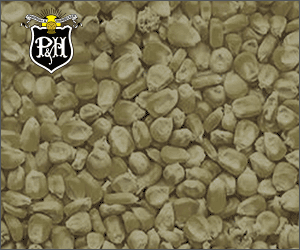Research roundup
FIND OUT WHAT’S NEW IN THE WORLD OF RESEARCH
A bottom-up approach to dealing with drought
Mallory Kohn
The Sand Plains region in Ontario is one of the most productive areas for corn. But because of the nature of the sandy soil, through which water quickly drains, it is also one of the province’s most drought-prone regions. This kind of water stress negatively affects corn growth, development, and yield.
University of Guelph professors Rene Van Acker and John O’Sullivan, in the Department of Plant Agriculture, and technicians Robert Grohs and Peter White are trying to determine if subsurface drip irrigation (SDI) can significantly help crop production in the Sand Plains. SDI technology is new to Ontario. It involves applying water directly to the roots of crops below the soil surface through drip-irrigation lines. It’s a low-pressure system with a one-time installation and life expectancy of 20 years.
SDI can deliver water with an efficiency of 95 per cent or higher and requires less energy resulting in energy cost savings. It also improves corn yield and quality, irrigation and nutrient application efficiency, and facilitates environmental sustainability by improving nitrogen use efficiency.
The team is currently in the process of commercializing and expanding the market for subsurface drip irrigation. Collaborators include Judge Farms and Vanden Bussche Irrigation.
Funding is provided by the University of Guelph/OMAFRA through Gryphon’s LAAIR, and Farm and Food Care Ontario through the WAMQI program. •
A new type of corn for ethanol production
Anna Wassermann
The process of converting grain to ethanol is rather time consuming; grain needs to be mechanically broken down, liquefied, and supplemented with enzymes before it can be fermented to ethanol. But a newly developed type of corn known as “sugarcorn” contains juice that is ready for fermentation, allowing ethanol industries to expedite ethanol production while saving costs.
Dr. Robert Nicol, the lead biofuels researcher at the Centre for Agricultural Renewable Energy and Sustainability at the University of Guelph Ridgetown Campus, is investigating how sugarcorn can be processed for sugar and used as a feedstock for various biofuel or bioproduct applications.
Sugarcorn is a type of corn developed for producing large amounts of sugary juice in the stalk. Like sugar cane, the sugarcorn stalks are pressed to release the juice, which is fermented with yeast to produce ethanol. Unlike grain, the sugarcorn juice is high in sucrose so it doesn’t require the addition of enzymes.
According to Nicol, it’s risky to introduce a new product with only one application, which is why he’s also investigating whether the remaining corn residue can be optimized for other uses.
Specifically, Nicol is interested in whether the remaining corn stalks can be used as feedstock for biogas — a form of methane combusted to produce electricity — or ensiled to produce animal feed. Both uses would provide industries with additional revenue streams.
“Sugarcorn has shown that it produces excellent ethanol yield and saves costs,” says Nicol. “Whether it supplements corn grain or is the basis for a new corn to ethanol process altogether, the next step is to engage industries in the idea of a new feedstock.”
Also involved in this research are Agriculture and Agri-Food Canada research scientists Lana Reid and Malcolm Morrison and University of Guelph Ridgetown Campus researcher Doug Young.
Funding for this project was provided in part by Agriculture and Agri-Food Canada through the Agricultural Adaptation Council’s CanAdvance Program. •
Determining corn’s nitrogen requirement
Anna Wassermann
Effective application of nitrogen fertilizer can help growers maximize crop yield and profitability. But determining the correct rate of fertilization is a difficult process, because the optimum nitrogen application rate varies within and across fields and across years.
To better match nitrogen requirements with application rates, University of Guelph plant agriculture professor Bill Deen and his team investigated how requirement varies across years.
In a long-term trial of nitrogen established at the Elora Research Station in 2008, soil type, management, and hybrid optimal nitrogen rates varied from 145-255 kg N ha-1.
According to Deen, the variation in nitrogen requirement can be attributed to differences in weather from year to year. Deen found that variation appears to be caused by weather events occurring after corn has already been side dressed with nitrogen fertilizer.
Various tests are available to assess either corn or soil nitrogen status at the time of side dressing. These tests provide a snapshot of weather effects on current soil or corn condition but do not capture the future weather effects on soil nitrogen or corn nitrogen demand.
“Nitrogen status at the time of side dressing is not necessarily a good predictor of corn nitrogen requirements because weather effects on corn nitrogen requirement may be mostly determined after nitrogen is applied,” says Deen.
Deen’s University of Guelph collaborators were Ken Janovicek and John Lauzon. Also involved in this research were International Plant Nutrition Institute director Tom Bruulsema and Ontario Ministry of Agriculture, Food and Rural Affairs (OMAFRA) corn specialist Greg Stewart.
Funding for this research was provided by the International Plant Nutrition Institute, the Ontario Agribusiness Association, and OMAFRA. •
Research Roundup is provided by members of SPARK (Students Promoting Awareness of Research Knowledge) at the University of Guelph’s Office of Research. For more information, contact a SPARK writer at 519-824-4120, ext. 52667.




















